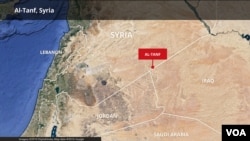American military officials say U.S.-backed Syrian Democratic Forces have pushed within three kilometers of Islamic State's de facto capital in Syria, and that the major battle for control of Raqqa "could begin in the coming days."
Speaking to reporters from Baghdad, Colonel Ryan Dillon, spokesman for the U.S.-led counter ISIS coalition, said the SDF was "poised around Raqqa" after gaining 350 square kilometers from IS in Syria in the last week.
The forces are within three kilometers of Raqqa to the north and east and within about 10 kilometers of the city to the west, Dillon said.
"The fight for the city could begin in the coming days," a U.S. military official separately told VOA on the condition of anonymity. "The encirclement of Raqqa is almost complete."
The U.S. military confirmed earlier this week that it had started distributing weapons and vehicles to Syrian Kurdish fighters in preparation for the Raqqa battle. That move has placed the United States at odds with NATO ally Turkey, which contends the SDF's Syrian Kurdish militia is a terrorist group affiliated with the outlawed PKK, the Kurdistan Workers' Party, a terror group that has been battling the Turkish state for many years.
Dillon said the SDF had instructed Raqqa citizens to leave the city ahead of the fighting, with nearly 200,000 people already displaced. Camps for displaced citizens have been established around the Syrian city, Dillon added, with SDF screening sites in place to prevent IS militants from escaping among the fleeing civilian population.
Problem near al-Tanf
Meanwhile, U.S. military officials said Iranian-backed pro-regime forces were continuing to violate a deconfliction zone set up around the al-Tanf army base, where special forces are training Syrian militias.
Dillon said the coalition had communicated to the "small element" of forces that they were considered a threat and needed to leave the zone.
"We want them out of there," he told reporters Thursday from Baghdad.
Dillon said the forces violating the deconfliction zone had stopped establishing defensive positions after coalition airstrikes targeted their tanks and equipment two weeks ago, but had remained a little more than halfway into the established zone, which has a radius of 55 kilometers from the al-Tanf base.
"It's not like they've dipped their toe into the deconfliction zone. They're well inside it," said Dillon.
Additional pro-regime reinforcements have not entered the deconfliction zone, Dillon said, but forces just outside the zone at al-Tanf are reinforcing their positions and bringing in combat-type assets, including tanks and artillery systems.
"All these things put together present a threat to the coalition forces," he said.


